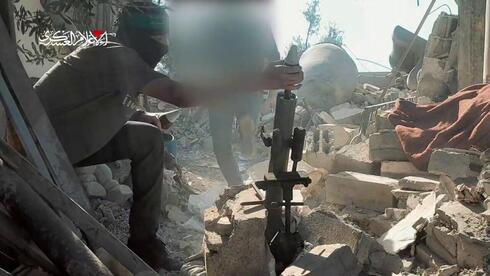More than a month after Hamas terrorists stormed an IDF position in Khan Younis, the group has released a seven-minute video documenting the attack. The footage, filmed in daylight and edited for propaganda purposes, sheds light on Hamas’ methods and the threats still facing Israeli troops nearly two years into the war.
The video appears aimed at two audiences: Israel, as proof that Hamas remains active and capable of launching raids inside Gaza, and supporters of the terror group in the Strip, as encouragement to continue attacks on IDF positions.

 The raid struck a defensive position held by the Kfir Brigade along the Magen Oz axis. These types of positions — where smaller groups of soldiers remain behind while larger forces advance — have become prime targets for Hamas, which seeks either an operational achievement such as a mass-casualty attack or the abduction of a soldier that could be portrayed as a symbolic victory.
The raid struck a defensive position held by the Kfir Brigade along the Magen Oz axis. These types of positions — where smaller groups of soldiers remain behind while larger forces advance — have become prime targets for Hamas, which seeks either an operational achievement such as a mass-casualty attack or the abduction of a soldier that could be portrayed as a symbolic victory.
Once Israeli forces establish control from such positions, Hamas begins collecting intelligence on them. The video, taken from last month’s attack, illustrates how immediate and serious the threat remains. Lessons from the incident have already been shared across Gaza, including lapses in security procedures, low levels of alertness and errors in setting up ambushes.
The video shows the terrorists divided into three squads: one providing suppressive fire with machine guns, another with anti-tank weapons aimed at expected reinforcements, and two assault teams moving toward buildings believed to contain Israeli soldiers.
One building had been deliberately vacated, but the other still housed troops. About 15 soldiers were resting inside after a night mission, with one standing guard at the entrance.
The terrorists managed to reach the entrance of the occupied building and engaged the troops at close range. One soldier was seriously wounded and two others lightly hurt. A commander upstairs, who had noticed suspicious activity in the area, issued a last-minute warning that gave the soldiers a chance to fight back.
The confrontation unfolded in seconds, with troops forced to fight immediately upon waking. Such a scenario, inside what is supposed to be a fortified position, is considered a serious security breach.
The IDF said the soldiers were fortunate. Grenades thrown into their room failed to detonate, forcing the terrorists to retreat. Most of the attackers were later killed in Israeli airstrikes and by a reinforcing tank, though some escaped through tunnels near the displaced persons camp in Mawasi.
The footage highlights Hamas’ reliance on camouflage blankets to evade surveillance, drones for propaganda and reconnaissance, binoculars to track troop movements, and cranes fitted with Israeli observation gear. It also confirms that Hamas still operates a large tunnel network in Khan Younis, despite previous Israeli operations in the area.
The terrorists were armed with “Shawaz” explosives, RPGs, Kalashnikov rifles and stolen IDF weapons, including M4 and Micro-Tavor rifles. In one striking moment, two attackers stormed directly into the entrance of the building — an area that should have been secured — and even climbed the first staircase. Meanwhile, a Hamas mortar squad fired from a distance to try to isolate the position.
Although the terrorists failed to kill or abduct soldiers, they have continued launching raids almost daily across the Gaza Strip. In the south, they target defensive positions along supply routes such as Magen Oz and Morag, while in the north they focus on positions connected to renewed IDF maneuvers in Gaza City.
About two weeks after the Kfir Brigade incident, another Hamas unit attempted to raid a nearby post but discovered it had already been abandoned. A day later, terrorists tried again at a different position but were detected in advance by Israeli intelligence. Troops responded, killing several attackers and forcing the rest to flee.
The IDF has since begun replacing some temporary defensive positions with more fortified outposts along the logistical routes in Khan Younis. The new structures are intended to provide greater safety and operational effectiveness. Still, missions in the area remain largely defensive, prompting the army to increase intelligence and airpower support for troops on the ground, even as attention shifts to ongoing operations in Gaza City.

